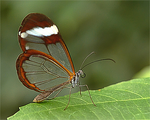MAY 04, 2018
By Anni Griswold and Kanaga Rajan
Comprehensive Ophthalmology, Glaucoma, Ocular Pathology/Oncology
A weekly roundup of ophthalmic news from around the web.
 A new self-monitoring IOP device draws inspiration from an unlikely source: the glasswing butterfly. The implantable sensor, designed by Caltech engineers and described in Nature Nanotechnology, is covered with nanostructures like those found on the butterfly’s translucent wings. The new design skirts issues with the team’s previous version, which required both reader and sensor to remain perpendicular for accurate readings. University of California San Francisco
A new self-monitoring IOP device draws inspiration from an unlikely source: the glasswing butterfly. The implantable sensor, designed by Caltech engineers and described in Nature Nanotechnology, is covered with nanostructures like those found on the butterfly’s translucent wings. The new design skirts issues with the team’s previous version, which required both reader and sensor to remain perpendicular for accurate readings. University of California San Francisco
Contact lenses that flash light from ultra-thin lasers are now a thing. In the presence of blue light, the lasers emit carefully calibrated light beams that act as visual barcodes or “wearable security tags,” scientists write in Nature Communications. Unlike rigid lasers of days past, the new lasers are ultrathin, lightweight and flexible—perfect for imbedding into bank notes, contact lenses (shown above) and other objects. University of St Andrews
A rare eye cancer is mysteriously targeting small Southern towns. Uveal melanoma normally strikes 5 people in 1 million, but in recent years the cancer has appeared in 18 residents of Huntersville, North Carolina, and 33 residents of Auburn, Alabama. The cases share striking similarities: Many are women, most are younger than the typical age at diagnosis and several are Auburn University alums. The state of North Carolina has set aside $100,000 to study the disease cluster, and Alabama researchers are lobbying for research funds from the CDC and the NIH. Healthline
Novartis says phase 3 data for brolucizumab support a 12-week treatment interval for patients with neovascular AMD. At this week's Association for Research in Vision and Ophthalmology conference, researchers said the findings may also help predict, with 90% accuracy, which patients will benefit from an 8-week versus a 12-week regimen. Reuters
 Dark chocolate may boost your vision, at least during the snack’s afterglow. These delicious findings emerged from a very official—randomized, single-masked crossover—clinical trial where 30 participants ate either a dark chocolate or milk chocolate bar. Two hours later, researchers found small but significant improvements in visual acuity and contrast sensitivity among those who consumed dark chocolate, compared with the milk chocolate group. JAMA Ophthalmology
Dark chocolate may boost your vision, at least during the snack’s afterglow. These delicious findings emerged from a very official—randomized, single-masked crossover—clinical trial where 30 participants ate either a dark chocolate or milk chocolate bar. Two hours later, researchers found small but significant improvements in visual acuity and contrast sensitivity among those who consumed dark chocolate, compared with the milk chocolate group. JAMA Ophthalmology